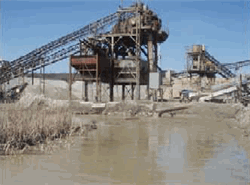Mineral Mining and Processing Effluent Guidelines

The EPA promulgated the Mineral Mining and Processing Effluent Guidelines and Standards (40 CFR Part 436) in 1975, and amended the regulation in 1976, 1977, 1978, and 1979. The regulation covers wastewater discharges from mine drainage, mineral processing operations and stormwater runoff. The Mineral Mining regulatory requirements are incorporated into NPDES permits.
On this page:
What is Mineral Mining?
Facilities Covered
- construction materials (e.g., stone, gypsum, asphalt, sand & gravel); NAICS 21231, 212319, 212321, 212399.
- minerals used in the chemical & fertilizer industries (e.g., borax, potash, magnesium, phosphate); NAICS 212391, 212325, 212392.
- miscellaneous minerals (e.g., barite, bentonite, graphite); NAICS 212393, 212325, 212399.
Subcategories
- Crushed Stone
- Construction Sand and Gravel
- Industrial Sand
- Gypsum
- Asphaltic Mineral
- Asbestos and Wollastonite
- Barite
- Fluorspar
- Salines From Brine Lakes
- Borax
- Potash
- Sodium Sulfate
- Phosphate Rock
- Frasch Sulfur
- Bentonite
- Magnesite
- Diatomite
- Jade
- Novaculite
- Tripoli
- Graphite
Rulemaking History
1979 Amendment
- Documents, including:
- Final Rule (December 28, 1979)
- Development Document
This publication includes technical documentation for the 1979, 1976 and 1975 final rules, and the basis for draft limitations in additional subcategories. It describes industry processes, subcategories, pollutants generated, available control and treatment technologies, the technical basis for the rules, and costs of the rules.
1978 Amendment
- Documents, including:
- Final Rule (March 10, 1978)(BAT & PSNS proposals withdrawn)
- Proposed Rule (June 10, 1976)(BAT, PSNS & NSPS)
1977 Amendment
- Final Rule (July 12, 1977)
1976 Amendment
- Documents, including:
- Interim Final Rule (June 10, 1976)
- Development Document
1975 Initial Rulemaking
- Documents, including:
- Interim Final Rule (October 16, 1975)
- Development Document
